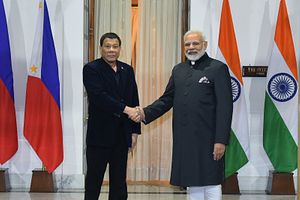Last week, we heard renewed talk of the Philippines’ interest in acquiring Brahmos missiles from India. While speculation about such a deal is far from new, it has nonetheless spotlighted the significance of an ongoing activity between the two countries which, if materialized, could extend beyond their bilateral relationship.
As I have observed before in these pages, while defense collaboration between India and the Philippines has been quite basic up to this point, with areas such as naval ship visits, training, and education, there have been efforts by both sides to boost this aspect of ties still further in realms such as military equipment and maritime security amid wider regional developments, including concerns about aspects of China’s behavior and broader convergences tied to the Indo-Pacific. This has continued on into 2019 as well, which marks the 70th anniversary of the establishment of diplomatic ties between the two countries.
One of the aspects of this has been the sale of India’s Brahmos supersonic missiles to the Philippines. Speculation of a deal has been surfacing periodically, even though few specifics have been publicly released by both sides. Last week, we saw the firmest confirmation of this by Philippine Defense Secretary Delfin Lorenzana, who said on December 16 that the signing of the contract would probably occur in 2020, possibly in the first or second quarter, and confirmed that adequate budgeting had been allocated for the sale to materialize.
Assuming that it does occur as has been indicated, the development would be significant. At the most basic level, this would be a boost for the Philippine military’s deterrent capabilities, as Lorenzana noted, as well as an additional avenue for collaboration within the India-Philippines defense relationship as discussed previously.
But the implications of this deal would reach beyond just the bilateral relationship. The spotlight on the Philippines as the potential first export customer of the Brahmos would represent a gain for Indian defense and would also serve as another tangible reinforcement of India’s growing security role in the region, which has been more visible under Prime Minister Narendra Modi. And assuming that the deal materializes as both sides intend, the focus will then move on to other potential customers in Asia and the impact of sales on India’s wider regional alignments.
To be sure, a much more robust assessment of the deal will only be possible once we see further inroads and the public release of more details surrounding it. And as with any defense deal, the broader strategic significance of a Brahmos deal for the Philippines should be checked against the operational realities of securing and then implementing the agreement. Nonetheless, given the potential significance of this development, it will nonetheless remain one that will continue to be closely watched for the headlines it generates in the coming months.
































